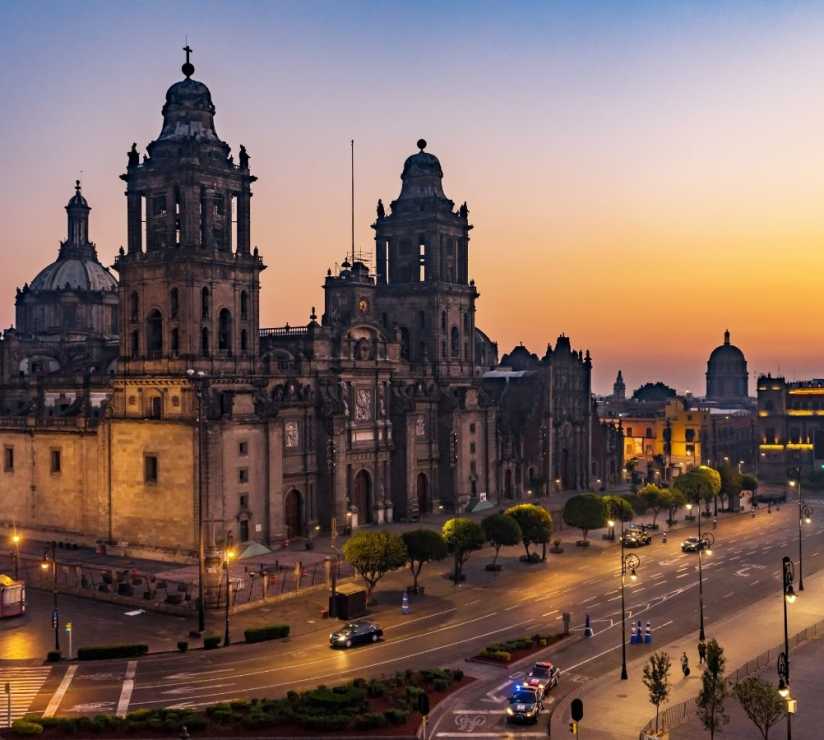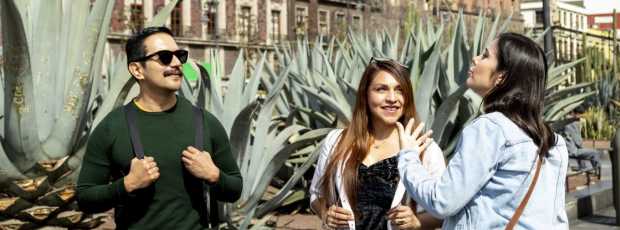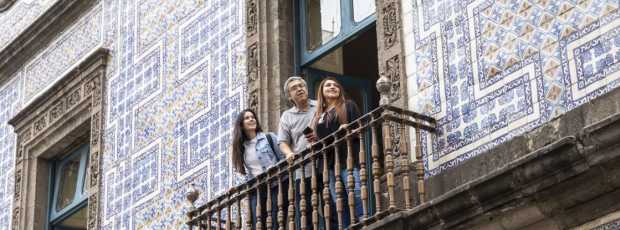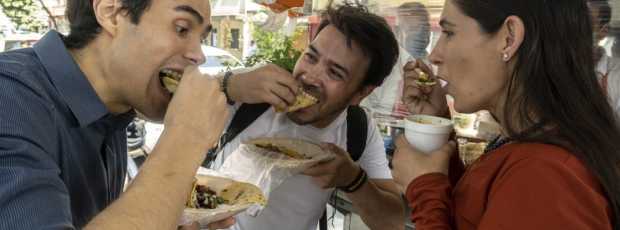Table Of Contents
- Starting Strong: Breakfast in the Heart of Everything
- Walking Through Centuries: The Historic Core
- Mid-Morning Architecture: Art Deco and Grand Designs
- Lunch Break: Street Food Without the Tourist Traps
- Afternoon Culture: Fine Arts and Public Spaces
- Late Afternoon: Neighborhoods Beyond the Tourist Zone
- Evening Plans: Food, Music, and Night Markets
- Night Culture: Lucha Libre and Local Entertainment
- Practical Tips for Your Day
- Where to Save Money Without Sacrificing Experience
- Making Connections: Beyond Tourist Experiences
- Reflections on One Perfect Day
Here's what I learned during my own experiment with fitting Mexico City into a single day. The secret isn't seeing everything. It's feeling something. After living here for three years and watching friends attempt marathon sightseeing sessions, I crafted an itinerary that actually works. No sprinting required.
Starting Strong: Breakfast in the Heart of Everything
The historic center wakes up differently from the rest of Mexico City. By 7 AM, street vendors are already setting up their stalls around the main square. The aroma of coffee mingles with car exhaust in that distinctly Mexican way. I always start my ideal morning at Casa de los Azulejos, not just for the Instagram-worthy blue tiles, but because their hot chocolate recipe hasn't changed since 1917.
(Honestly, I'm obsessed with their hot chocolate. My friends tease me about it, but whatever.)
Casa de los Azulejos sits like a jeweled box on Madero Street. Its facade is covered in intricate white tiles that catch the morning light. Inside, the restaurant occupies a colonial courtyard where you can order hot chocolate thick enough to coat a spoon. The building itself tells Mexico’s story. It was originally a palace, then a revolutionary meeting place. Now, it’s a restaurant where businesspeople eat breakfast alongside curious travelers.
The breakfast here costs about 200 pesos ($12 USD). That might seem steep, but you're paying for more than food. You're sitting in a piece of Mexico's past. You're surrounded by murals and art nouveau details that most people rush past. Plus, the thick chocolate will fuel you for hours of walking.
Quick tip: Arrive before 8:30 AM to avoid tour groups. The second floor offers quieter seating with better views of the courtyard. (I learned this the hard way after getting stuck behind a group of 30 people taking identical photos for twenty minutes.)
Walking Through Centuries: The Historic Core
From Casa de los Azulejos, the Centro Historico spreads out like a living museum. This UNESCO World Heritage Site contains over 1,400 colonial-era buildings. Each one holds stories that stretch back to the Aztec era. Instead of trying to see everything, I focus on three key stops. They capture different layers of Mexico City's evolution.
The Templo Mayor ruins sit just steps from the main cathedral. They offer a glimpse into the ancient city of Tenochtitlan. The main temple of the Aztec people was discovered accidentally in 1978 when electrical workers found a massive stone disc. Now it's a small museum that shows how Spanish colonizers literally built their city on top of the Aztec capital.
The entrance fee is only 85 pesos ($5 USD), making it one of the best ways to save money while gaining historical context. The museum displays artifacts that reveal daily life in the Aztec marketplace. Everything from obsidian blades to ceramic toys. Spending 45 minutes here transforms the rest of your Mexico City experience from simple sightseeing into time travel.
The National Palace: Where Art Meets Government
Across the Plaza de la Constitución, the National Palace houses both Mexico's government and some of Rivera's most powerful murals. Entry is free, but you'll need to show identification and pass through security. The Diego Rivera murals on the second floor cover three walls with scenes from Mexico's pre-Columbian past through the Mexican Revolution.
These aren't just pretty pictures, Rivera painted Mexico's entire social and political history across these walls. The central mural depicts the Spanish conquest, indigenous resistance, and modern industrial progress in vibrant detail. Standing in front of these works, you understand why Diego Rivera remains one of Latin America's most influential artists.
Time-saving tip: Focus on the main staircase murals rather than trying to see every room. The guards are usually happy to point out key details if you ask politely in Spanish.
Looking for a private city experience in Mexico City?
Explore the city with a local who plans a private day just for you; no groups, no scripts.
Mid-Morning Architecture: Art Deco and Grand Designs
Walking north from the National Palace, the Palacio de Bellas Artes emerges like a white marble wedding cake topped with orange domes. This art museum represents everything ambitious about early 20th-century Mexico, art deco exterior, art nouveau interior, and revolutionary murals by Diego Rivera, Orozco, and Siqueiros inside.
The building itself is an architectural balancing act. Construction began in 1904 but wasn't completed until 1934 because the structure kept sinking into Mexico City's soft lake bed. Today, it houses both fine arts exhibitions and opera performances. The observation deck on the fourth floor offers panoramic views across the historic center.
Admission costs 75 pesos ($4.50 USD) for the permanent collection, which includes more Diego Rivera murals alongside rotating contemporary exhibitions. The fine arts displayed here range from pre-Columbian artifacts to cutting-edge installations by Mexican artists you've probably never heard of but should.
The Postal Palace: Unexpected Beauty
Just around the corner, the Palacio Postal (Post Office) demonstrates that even utilitarian buildings can be gorgeous. This Art Nouveau palace, completed in 1907, features a bronze and glass facade that looks more like a luxury hotel than a mail sorting facility.
The interior showcases Italian marble, Venetian crystal, and bronze fixtures that make posting a letter feel ceremonial. Most tourists skip this building, but it's free to enter and represents the kind of architectural ambition that defined early modern Mexico. Plus, you can actually mail postcards from here, not bad for a post office.
Lunch Break: Street Food Without the Tourist Traps
By noon, your feet will be tired and your stomach will be demanding attention. Instead of settling for overpriced restaurant food near the main tourist sites, walk ten minutes south to Mercado San Juan. This market caters primarily to local chefs and serious food lovers, meaning the quality is exceptional and prices remain reasonable.
Mercado San Juan occupies a sprawling building that's part grocery store, part food court, and part culinary adventure. The street food here includes exotic ingredients like crocodile meat and escamoles (ant larvae), but you can also find perfectly executed traditional dishes.
I always order al pastor tacos from the stand near the main entrance. The trompo (vertical spit) spins slowly while the taquero shaves off perfectly charred pork, tops it with pineapple, and serves it on fresh tortillas. Three tacos cost about 60 pesos ($3.50 USD), and they're better than most restaurant versions that cost three times as much.
Money-saving strategy: Eat where the vendors eat. Look for stalls crowded with market workers rather than tourists. The duck carnitas from the stand in the back corner are legendary among local chefs.
Afternoon Culture: Fine Arts and Public Spaces
After lunch, the Alameda Central provides a perfect place to digest while people-watching. This park has served as Mexico City's central green space since 1592. It evolved from a colonial promenade to a democratic gathering place where families visit, mariachi bands perform, and office workers eat lunch.
The park anchors a district filled with architectural gems. The Palacio de Bellas Artes dominates the eastern edge, while smaller museums and galleries dot the surrounding streets. It's the kind of area where you can just follow your curiosity.
Hidden Gem: The Franz Mayer Museum
Two blocks from Alameda Central, the Franz Mayer Museum occupies a beautifully restored colonial hospital. This art museum focuses on decorative arts, furniture, textiles, ceramics, and silver, that tell the story of daily life across Mexico's colonial period.
The museum's rooftop terrace offers one of the best views in the historic center, looking out over church domes and colonial facades toward the mountains that ring Mexico City. Admission costs 60 pesos ($3.50 USD), and the museum is small enough to visit completely in 45 minutes.
Insider tip: The museum shop sells high-quality Mexican handicrafts at fair prices. It's one of the few places in the center where you can buy authentic crafts without haggling.
What if your day in Mexico City was planned by someone who knows it — and you?
City Unscripted matches you with a local host who creates a private experience based on your interests, not a set route.
Late Afternoon: Neighborhoods Beyond the Tourist Zone
By 3 PM, most visitors are exhausted from cramming too much into their itinerary. This is when I recommend slowing down and exploring Roma Norte. It's a neighborhood that showcases contemporary Mexico City culture without completely abandoning historical context.
Roma Norte sits about 15 minutes by metro from the historic center. The neighborhood features tree-lined streets, art deco apartment buildings, and a cafe culture that feels distinctly Mexican. Not trying to imitate Brooklyn or Paris.
The plaza at the heart of Roma Norte hosts weekend markets and evening concerts. During weekdays, it's a quiet space where locals read newspapers and students study under jacaranda trees. This is where you'll understand Mexico City as a place where people actually live rather than just visit.
Coffee Culture and Local Life
Roma Norte coffee shops serve excellent Mexican beans alongside pastries that blend French techniques with local ingredients. Café Negro, tucked into an art deco building on Colima Street, roasts their beans. They serve them in a space that feels like someone's stylish living room.
A cappuccino costs about 55 pesos ($3.25 USD). The baristas know how to make proper espresso. This is where Mexico City's creative class meets to work and socialize. Designers, writers, photographers. Spending an hour here provides insight into contemporary Mexican urban culture that most tourists never experience.
Evening Plans: Food, Music, and Night Markets
As evening approaches, Mexico City transforms. The formal business atmosphere gives way to a more relaxed energy. Families gather for dinner, and young people begin their nightlife routines. This is when the street food culture really comes alive.
Instead of expensive restaurant meals, I recommend experiencing Mexico City's evening street culture. Mariachi music drifts from plaza gatherings. Street vendors set up elaborate taco operations. Locals emerge for their evening paseos (walks).
Taco Crawl: The Real Mexico City Dinner
The best tacos in Mexico City aren't served in restaurants. They come from street vendors who set up elaborate operations every evening. My favorite taco crawl starts in the Centro Historico and winds north toward Alameda Central. I hit three or four stands that specialize in different preparations.
Al pastor remains the most famous style, but try carnitas (slow-cooked pork), suadero (beef brisket), and chorizo for a complete education. Each style requires different preparation techniques and accompaniments. Good tacos cost 15-20 pesos each (about $1 USD). A full dinner ends up being extremely affordable.
Street food etiquette: Don't ask for modifications. Trust the taquero's expertise and eat the tacos exactly as served. Each vendor has perfected their recipes over the years or decades.
Night Culture: Lucha Libre and Local Entertainment
If you're spending just one day in Mexico City, experiencing lucha libre provides a uniquely Mexican entertainment experience. Arena México, the cathedral of Mexican wrestling, hosts matches on Tuesday, Friday, and Sunday evenings.
Lucha libre combines athletic performance with theatrical storytelling. Masked wrestlers (rudos and técnicos) battle while crowds cheer, boo, and throw beer cups. It's essentially Mexican opera performed in spandex and masks.
Tickets cost 50-200 pesos ($3-12 USD) depending on seating. The cheap seats offer the most authentic experience, you'll sit with families who've been attending for generations and who know every wrestler's history. The fun experience lies not just in the wrestling but in the crowd participation and theatrical drama.
Cultural note: Lucha libre reflects Mexican attitudes toward honor, justice, and social struggle. The masked heroes represent ordinary people fighting against corruption and oppression.
Tip
We match you with the right host, not just any guide.Want to experience the real Mexico City with someone who lives there?
A fully private experience, planned and led by a local host who tailors the day to you
Practical Tips for Your Day
Successfully navigating a single day in Mexico City requires some practical planning. The historic center is walkable, but the city's altitude (7,350 feet) can leave visitors breathless if they're not prepared. The air quality varies daily. Afternoons often bring brief but intense rainstorms.
Transportation: The metro system is extensive and cheap (5 pesos per ride). It can be crowded and confusing for first-time visitors. Uber and local taxis work well for longer distances. Walking remains the best way to experience the Centro Historico.
Money matters: Most museums and attractions accept only cash. ATMs are plentiful, but notify your bank before traveling. Street vendors only take cash, and tipping 10-15% is standard at sit-down restaurants.
Safety: The historic center is generally safe during daylight hours, especially in areas with heavy foot traffic. Avoid displaying expensive electronics, and trust your instincts about crowds and situations.
Where to Save Money Without Sacrificing Experience
Spending a single day in Mexico City doesn't have to break your budget. Many of the best experiences are free or very inexpensive. Walking through colonial streets, viewing Diego Rivera murals, and people-watching in plazas.
Free activities: Walking the Centro Historico, visiting the National Palace, exploring Alameda Central, and window shopping on Madero Street.
Low-cost experiences: Museum admissions (typically $3-5 USD), street food meals ($5-8 USD), local transportation ($0.30 per metro ride).
Where to splurge: Quality coffee in Roma Norte, a nice restaurant dinner if you prefer sit-down dining, and lucha libre tickets for better seats.
Budget breakdown: A comfortable day in Mexico City, including meals, transportation, and museum admissions, costs $40-60 USD per person. Street food enthusiasts can manage for $25-35 USD.
Making Connections: Beyond Tourist Experiences
The most memorable Mexican experience happens when you move beyond pure sightseeing toward cultural connection. This might mean asking a museum guard about their favorite Rivera painting. Learning a few Spanish phrases to use with street vendors. Or simply sitting in a plaza long enough to observe local social rhythms.
If you visit Mexico City with genuine curiosity, the city rewards you generously. This city rewards curiosity over efficiency. The tourist who spends 30 minutes watching a street performer will have richer memories than someone who checks off five museums in the same time period.
Language and Cultural Tips
Basic Spanish phrases transform your experience. "¿Qué recomienda?" (What do you recommend?) works magic with restaurant servers and food vendors. "¿Puedo tomar una foto?" (Can I take a photo?) shows respect when photographing people or their businesses.
Mexican hospitality is genuine but not pushy. People appreciate visitors who show interest in their culture beyond just consuming it. Asking about local art, food, or music usually generates enthusiastic responses and insider recommendations.
Ready to plan your perfect day in Mexico City?
Start your experienceReflections on One Perfect Day
After testing this itinerary with friends, family, and visiting colleagues, I've learned something important. The perfect day here balances scheduled activities with spontaneous discoveries. The framework provides structure, but the magic happens in unplanned moments. Conversations with locals, unexpected street performances, or simply the perfect bite of al pastor at golden hour.
This city can't be conquered in one day, but it can be genuinely experienced. The goal isn't comprehensive coverage but authentic connection. Whether you're on a layover, taking a day trip from another Mexican destination, or starting a longer journey, this approach provides enough structure to feel productive. It leaves room for the serendipity that makes travel memorable.
The key insight from my experiment: Mexico City rewards depth over breadth. Better to spend two hours really experiencing the Palacio de Bellas Artes than rushing through six museums for Instagram photos. Better to eat street tacos while chatting with vendors than dining in expensive restaurants designed for tourists.
One day in Mexico City isn't enough time to understand this complex metropolis, but it's plenty of time to fall in love with it. And falling in love, as any traveler knows, is the beginning of every great adventure.
Your day here will be different from mine. Different conversations, different discoveries, different perfect moments. But if you approach it with curiosity rather than a checklist, you'll leave with stories instead of just photos. And in a city as rich and layered as this one, stories are the only souvenirs that truly matter.
The places to visit in Mexico City are numerous, but the experiences that stick with you happen when you slow down enough to let the city reveal itself. That's the real secret to making the most of a single day here. Not seeing everything, but seeing something deeply enough that it changes how you understand this remarkable corner of the world.
What if your day in Mexico City was planned by someone who knows it — and you?
City Unscripted matches you with a local host who creates a private experience based on your interests, not a set route.
Want to experience the real Mexico City with someone who lives there?
A fully private experience, planned and led by a local host who tailors the day to you











